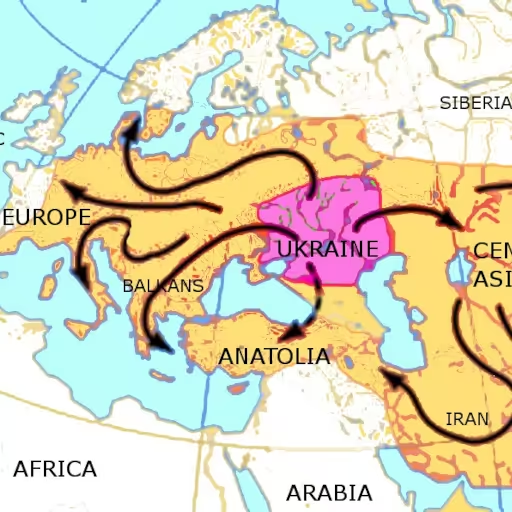Proto-Germanic ‘-z’ Suffix
Let’s explore the origins and evolution of the Proto-Germanic ‘-az’ suffix (i.e. -ᚨᛉ written in Germanic runes), and its connection to other Indo-European languages, as well as its reflexes in modern Germanic languages.
Abstract
The Proto-Germanic Masculine Nominative Singular Suffix *-az: A Reconstruction and its Reflexes
The Proto-Germanic (PGmc) suffix *-az has long been a central topic in historical linguistics, particularly within Indo-European and Germanic comparative studies. As the regular marker of the nominative singular masculine in Proto-Germanic strong a-stem nouns and adjectives, *-az represents a significant phonological and morphological development from its Proto-Indo-European (PIE) ancestor *-os. This article surveys the evidence supporting the reconstruction of *-az, its phonological derivation via sound laws such as Verner’s Law and the Germanic vowel shift, and its reflexes in attested Germanic languages. Special attention is given to runic inscriptions and fossilized remnants in modern Germanic forms.
1. Introduction Reconstructed forms such as *wôðanaz (“Odin”), *tīwaz (“Tyr”), and *hwewlaz (“wheel”) suggest the nominative singular masculine suffix *-az as a productive morphological feature in Proto-Germanic. However, this suffix has vanished or become morphologically opaque in the majority of descendant languages, raising questions about its origin, function, and phonological development.
2. PIE Origin and the Comparative Method The PIE masculine nominative singular suffix *-os (e.g., Latin domin-us, Greek hippos, Sanskrit devas) is the direct ancestor of PGmc -az. Through the comparative method, the PIE *-os is aligned with the PGmc *-az based on consistent sound correspondences:
- PIE *o > PGmc *a (via the Germanic vowel shift)
- PIE *s > PGmc *z (under certain conditions explained by Verner’s Law)
3. Verner’s Law and the Development of -az Verner’s Law states that voiceless PIE stops (and s) became voiced in PGmc when following an unstressed syllable in PIE. PIE stress patterns placed the accent on the root syllable, meaning that final *-s in *-os was in an unstressed syllable and thus voiced to z. Thus:
- PIE *-os > *-oz (Pre-Germanic, with *z from *s via Verner’s Law)
- *-oz > *-az (a change possibly influenced by analogical levelling or assimilation patterns within Germanic phonology)
4. Morphological Distribution The suffix -az functioned as a nominative singular masculine ending for strong a-stem nouns and adjectives. The morphological pattern is evidenced by reconstructed forms such as:
- wéraz (man)
- wísaz (wise)
- snelíkaz (quick)
5. Reflexes in Early Germanic Languages The most direct evidence for *-az comes from early Runic inscriptions and Proto-Norse. Notable examples include:
- Tune stone: woduridaz (personal name)
- Gallehus horn: hlewagastiz (personal name)
- Einang stone: godagastiz (personal name)
Icelandic and Old Norse preserve fossilized reflexes of -az as -r due to rhotacism:
- hringr (ring) < hringaz
- fálkr (falcon) < falkaz
In West Germanic, the ending was gradually lost or merged:
- Old English wer (man) < weraz
- Old High German man (man), wer < weraz
6. Preservation in Loanwords and Cognates Some loanwords into Uralic languages preserve the final -az more transparently:
- Finnish kuningas (king) < PGmc kuningaz
- Estonian kuningas (same origin)
These forms confirm the PGmc ending -az as fossilized in non-Germanic tongues, reflecting an earlier morphological state before Germanic internal erosion of final syllables.
7. Decline and Disappearance The erosion of final syllables in Germanic languages led to the disappearance of -az in most contexts. In Old Norse, this became -r due to rhotacism. In West Germanic languages, final -z became -r and was often dropped, particularly as final unstressed vowels disappeared (e.g., apocope in Old English).
8. Relation to Other Suffixes It is essential to distinguish -az from:
- Adjectival suffix -ig/-igaz*, which evolved into Modern English -y and German -ig (e.g., snêwaz “snow” > snîwigaz > OE snîwig > snowy)
- Adverbial suffix -līkaz, from PIE *-lġ-os, yielding English -ly, German -lich (e.g., frijôlīkaz > OE frēolic > Eng. freely)
9. Conclusion The suffix -az in Proto-Germanic is a well-supported reconstruction, grounded in the comparative method, phonological laws such as Verner’s Law, and early attested inscriptions. Although it has mostly disappeared from surface forms in later Germanic languages, its legacy persists in fossilized forms, conservative dialects, and loanwords. The suffix represents a critical link in the chain connecting PIE morphological structure with later Germanic grammar.
10. References
- Ringe, D. (2006). From Proto-Indo-European to Proto-Germanic. Oxford University Press.
- Fortson, B. W. (2010). Indo-European Language and Culture. Wiley-Blackwell.
- Robinson, O. W. (1992). Old English and its Closest Relatives: A Survey of the Earliest Germanic Languages. Stanford University Press.
- Krahe, H., & Meid, W. (1967). Germanische Sprachwissenschaft. Walter de Gruyter.
- Wiktionary and Etymonline entries on relevant PIE and PGmc forms.
- Proto-Norse inscriptions and Elder Futhark corpus (Kragehul, Gallehus, Tune, Einang Stones)
- Jespersen, O. (1954). Modern English Grammar. George Allen & Unwin.
- Grimm, J. (1822). Deutsche Grammatik, Vol. 1.









